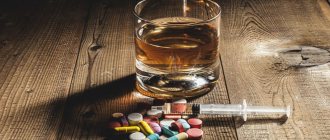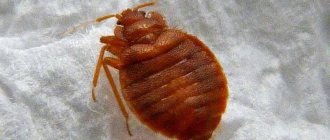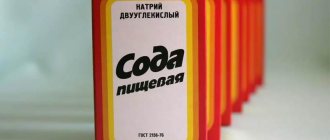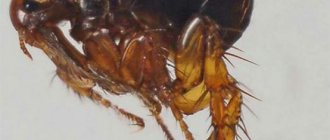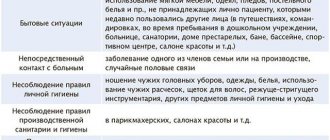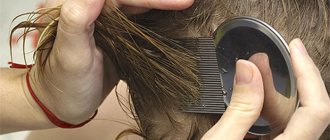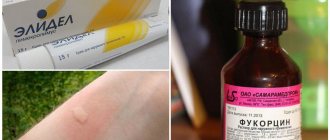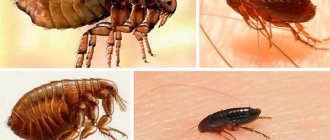Can lice live in pillows and on the sofa?
A common type of pest is the head louse. Parasites live in the hair of their host and need food all the time. Without a constant source of food, the insect dies.
Let's assume that the louse is outside the area of the human head; the fact of its viability under such conditions cannot be ruled out. For a certain time, lice on the pillow and in the sofa will not die.
Head louse are not found in feather pillows. The parasite is not adapted to a long stay in such conditions - the pest can remain in feathers only for a limited period of time, which cannot be said for the feather mite.
How long do nits live?
After the female louse has laid larvae on human hair, the eggs must go through 3 phases of development. A nit is a cocoon containing a future louse. During maturation, it does not need nutrition, so if for some reason it leaves the host’s body, it will be able to maintain its vital functions for about 8 days before hatching from the egg. If a small louse cannot immediately find food, it dies within 24 hours
For the maturation of nits, the most important is the temperature regime. If the nit is in hot conditions, the louse may hatch after 4-5 days. This is possible when wearing hats in winter, since a kind of greenhouse conditions are created under it. Therefore, after combing your hair, you need to thoroughly disinfect the entire room.
Do head lice live on clothes?
Body lice live on clothing and other textiles. They like to “settle” in the folds of underwear that come into contact with human skin.
This is a type of blood-sucking parasite; it immediately settles on the body of the representative as soon as he puts on clothes for the infection. It is not easy to distinguish the head individual from the clothes one: the head inhabitant has long thin legs (with which it holds onto the hair), while the clothes pest has squat, dense legs (they help the parasite move through the fabric).
Lifespan outside the human head
When dealing with pests, it is important to know how long lice live on human clothing and bedding. The life cycle of the parasite is relatively short. If the insect has not been poisoned or become entangled in hair, it can live for 40 days.
The louse is a parasitic organism - it is not capable of long life outside the host - the source of food. Lice live on the pillow as long as they can survive without food.
The parasite stays in the body of an adult for 30 days. During a period, a female reproduces 90 eggs. The incubation stage ends (from 7 to 10 days), the nit is born. Then she grows into an adult - the cycle is duplicated.
The louse ends up in household textiles - its life ends approximately on the 4th day. The insect can survive this period without a food source only if there is sufficiently warm air (at least 23 degrees).
If the ambient temperature rises, the life of the pest is shortened - it dies after about 24 hours. When the room is cool (up to 10 degrees), the body is able to live in interior items and on clothing for up to 12 days.
Head lice are always hungry, feeding on human blood every 4 hours - after this time they die outside the host.
Attention! The nit may be encased in a hard shell until favorable conditions for birth are provided.
Can nits survive without humans?
Lice eggs are called nits. During her life, the female lays up to 120 eggs. They are small, round, white and attached to the base of the hair with an adhesive substance. The larva matures in them within a week. The nit has a fairly strong shell that protects the larva from mechanical and partly from chemical damage.
nit on hair
When unfavorable conditions occur, nits, or more precisely, the larvae in them, are capable of falling into a state of suspended animation. This is a conditional deep sleep with “freezing” of all body functions. The larva stops its development, but remains alive. Some nits spend up to two weeks in a state of suspended animation. If after this they find themselves in normal conditions, they will continue their development and turn into adults, and then into adult lice.
Who can get infected and how?
Considering how long lice live on clothing, it is logical to ask the question of the likelihood of contracting head lice through non-contact means.
It is possible to become infected with lice without contact with a sick person. Among the possible ways :
- Body clothing, if worn by an infected member.
- Combs or other hair styling materials.
- Scarf, cap, hat worn by the patient.
- Use of public swimming equipment.
- Swimming in a river (insects remain viable in fresh water for up to 48 hours).
- Swimming in the pool (if an infected person swam in it before).
- Operation of common objects in groups - kindergarten groups, camps, etc.
How to get rid
It's time to learn the basic ways to eliminate lice from pillows and other household textiles.
The algorithm for registering actions against insects is extensive and simple.:
- Remove all items in direct contact with the patient. These are all items worn by an infected representative two days before the parasites were discovered. It is necessary to wash bed linen, towels, items of clothing (even outerwear), headbands, hair ties, pillows, etc.
- Sort out contaminated items. Group things by category:
- something that can be washed by hand or in a washing machine;
- items to be sent to the dry cleaner;
- items that cannot be subjected to any cleaning.
- Clear selected items. When planning a wash, set the maximum water temperature and dry linen, towels and other items on the heating element in order to eliminate the possibility of pests surviving.
For delicate items, choose an alternative cleaning option : simply soak them in warm water with powder for several hours and wash by hand.
Place dry clean only items in plastic trash bags and leave them there until it is time to dry clean them.
To get rid of lice on clothes and household items that do not tolerate either wet or dry cleaning, there are 2 alternative solutions to the problem:
- organization of a week-long quarantine. Place the items in a plastic bag, tie it tightly and leave for seven days. After a week, vacuum all components;
- when the first option is not suitable, leave the item (wrapped in a plastic bag) in the freezer for 4 hours. Adults cannot live at temperatures that are too low.
Room treatment
In the fight against insects, it is important not only to organize the care of textiles, but also to treat all surfaces in the room.
The table below shows the most effective formulations:
| Means | Method of preparation/use |
| Medifox | Emulsion (20%) in an amount of up to 10 ml is diluted in 1 liter of water. The treatment is carried out using gloves and a respirator. After half an hour the room is ventilated. If necessary, the procedure is repeated after a few days. |
| A-par | The product is suitable for clothing, soft toys, and furniture. The aerosol (by volume) is designed for an area of no more than 9 square meters. m. After treatment, items must be taken out into fresh air for 4 hours; the substance does not leave stains on the surface of the products |
| Avicin | The emulsion in an amount of up to 10 ml is diluted in 1 liter of water. A rag for the floor and doors is soaked in the solution. It can also be used using a spray bottle. You will need to wear gloves when handling the room, after which the apartment must be ventilated. Re-processing is not excluded |
| Kerosene and soap | Crushed tar soap and kerosene are prepared. The components are mixed in a 1:1 ratio. The composition will be used to wipe surfaces or soak contaminated items in it. After 4-5 hours, the treated surfaces are washed with clean water. |
Among other anti-lice remedies:
- sharp-smelling components (essential oils of lavender, citrus; pine, mint);
- turpentine (disadvantages: pungent odor, difficult to wash off from surfaces);
- vinegar (use pure solution or product).
Pharmacy treatments
The principle of treatment for pediculosis is based on the elimination of lice and the prevention of their further reproduction. For these purposes, special preparations are used in the following forms:
- shampoos;
- aerosols;
- lotions;
- sprays.
Shampoos are considered less effective than those listed above. Their action is aimed at deep penetration into the body of the parasite, as a result of which the insects die. The most popular are “Pedilin” and “Parasidosis”. The product must be applied to damp hair and left for 10-15 minutes. After this, the shampoo should be washed off and the hair should be combed with a comb. This procedure should be repeated once a week. Anti-head lice shampoo should only be used as directed by a doctor. Pregnant and lactating women, as well as children under 3 years of age, should avoid using it.
How to get rid of head lice not only on your head, but also on your clothes? A variety of aerosols are suitable for these purposes (for example, “Para-Plus” and “A-Par”). Some of them are used exclusively for treating clothing, while others can be used to eliminate lice on hair.
Aerosol "A-steam" is designed to eliminate insects from clothing. The product does not leave stains on the material, and the treated items do not require subsequent washing. However, you cannot put them on right away. It is better to leave it to ventilate for several days. It is recommended to process clothes with the window open. If the product gets on the mucous membranes of the eyes, they should be rinsed immediately under running water. It is prohibited to use hair spray as it contains toxic substances. Also, it should not be sprayed near children, other people, asthma patients, or pregnant women.
Para-Plus is considered a safer remedy. The aerosol can be sprayed onto the hair and scalp. After the procedure, you need to shower using regular shampoo. Dead lice and nits should be combed out with a comb. To prevent re-infection, personal hygiene products, underwear and clothing can be treated with this product. The instructions do not recommend it for use by children under 2 years of age and persons prone to allergies.
Various sprays (Paranit, Nyuda, Pediculen Ultra) are good against parasites. The listed drugs have proven themselves to be positive and are highly effective. They are a yellowish oily liquid. It has no characteristic odor. The action of such drugs is aimed at immobilizing insects and rapid death.
“Paranit” instructions recommend applying it to dry hair. After they become a little damp, the product should continue to be rubbed into the roots of the hair. In the case of long curls, they must be combed in separate strands. The applied drug is left for 15 minutes, after which it is washed off with regular shampoo. Dead lice and nits should be combed out with a comb. After this, the head is washed again with Paranit shampoo. If necessary, the procedure should be repeated every 10 days. This product is not recommended for use by pregnant and lactating women, children under 3 years of age and people with dermatological diseases.
Spray "Nuda" has a similar effect. It should also be applied to dry hair and rubbed into the roots. However, you must leave the product on for at least 45 minutes. After time, the remaining spray is washed off with shampoo, and dead parasites are combed out with a comb. The latter is sold together with the drug "Nyuda".
Preventive measures
Prevention of lice in the home involves regularly checking the heads of all family members (children attending child care institutions), washing and ironing clothes, bed linen and textile items.
If you suspect the development of pediculosis, you should treat the person’s head with a spray or wash it with anti-lice shampoo. When new pieces of furniture and clothing appear in a house or apartment, they must be carefully checked for the presence of parasites.
The louse can live in feather pillows, blankets, on the sofa, without a host for a certain time. The head louse is especially unstable: it is not capable of not feeding on human blood for several days: the parasite should eat every 4 hours.
Knowing how long the pest lives in conditions without human blood, we can state the fact of probable non-contact infection with lice. Compliance with preventive measures will help prevent this unpleasant phenomenon.
To get rid of insects forever, you will need to organize textile care and treat the premises with special means. All pest control operations are carried out using protective equipment.
